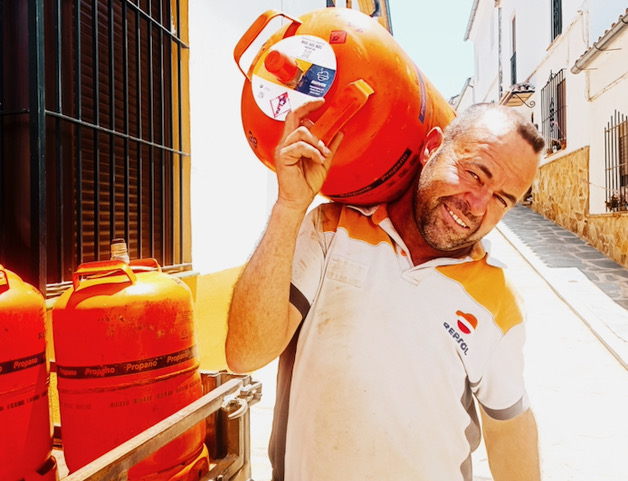
Rafa, el bombonero. Photo © Karethe Linaae
If you believe you have a tough job, think again. One of the most demanding occupations here in Spain must be to deliver the gas bottles to the country’s homes and businesses. I had a chat with our local bombonero and discovered that he lifts close to 10,000 kg – per day!
In almost every Spanish neighbourhood you know when el Repartidor de Butano is on his way. First, you hear the honking or beating on metal when they announce their arrival, and then the rattling from the truck as el butanero or el bombonero as the locals here call them, drive around to deliver the easily recognizable orange gas bottles simultaneously as they pick up the empties that residents leave outside their front doors.
Just like people in other parts of Europe got coal and firewood delivered to their homes in the old days, most of the Spanish population still receive gas on their doors – unless they live in a modern complex where the gas is supplied directly via pipes into the building. For us Scandinavians who associate gas with BBQs, cottages, and camping, it is a bit surprising to realize that gas is still delivered by hand to Spanish households. The tradition started under Franco when a state-owned gas company had a monopoly. And even if the gas companies now have steep competition from other energy sources, los bomboneros are still an important part of the Spanish streetscape.
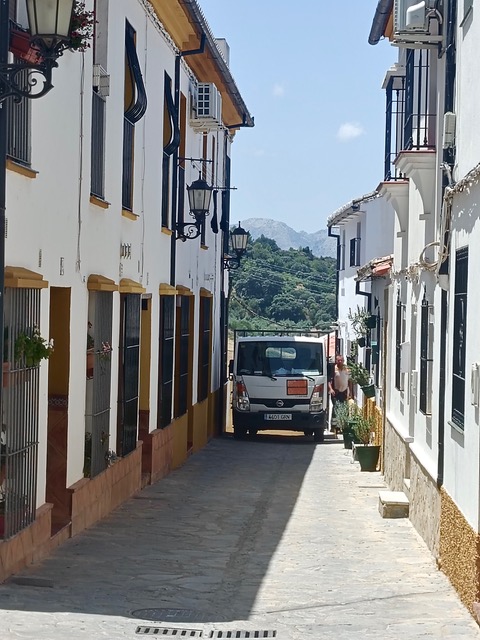
Deliveries in every street and alley. Photo © Karethe Linaae
45 % of the Spanish population – or more than 8 million households – still used gas for heating and cooking in 2020. The main reason is that gas is cheaper than electricity. Gas prices fluctuate amongst others due to transportation fees, crude oil prices and world events, and in the past decade, the price tag for a bombona has varied from ten to almost twenty euros. Some might have reservations about having something that explosive in our homes, but for people around here, that’s what people are used to.
The approximately 65 million gas bottles the Spaniards consume yearly are filled with liquid petroleum gas (LPG) or natural gas of either butane or propane. Most of the gas comes from the multinational Spanish company Repsol, which is the country’s biggest supplier with more than 2000 employees just delivering gas bottles all over Spain.
This not-very-enviable job is one that most of us simply couldn’t handle, if nothing else, due to the weight. So, who are these tough guys who pick up gas canisters like they were a litre of milk?
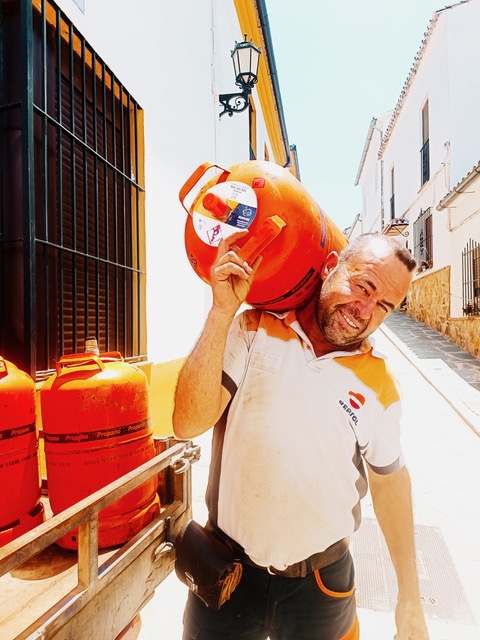
Rafael Dominguéz Naranjo. Photo © Karethe Linaae
Meet Rafa, el bombonero
Rafael Dominguéz Naranjo (48) is almost like an institution in the town of Ronda. Everybody knows him and expects his truck to come by every single tiny alley in each neighbourhood three times per week. I always look upon him with a mixture of awe and amazement when he picks up a gas bottle from the open truck, brings it straight up over the guard rail and onto his shoulder – hour after hour, day by day, in the frying Andalusian summer heat and howling winter storms. And if that isn't enough, Rafa is always smiling and friendly and even helps bring the monster inside the house should one need it. Despite the demands of the job, their salary is barely 10 euros per hour (June 2023), so a generous tip is not just good manners, but both well-deserved and should almost be obligatory!
One day I asked Rafa if I could interview him.
-Why on earth would you want to talk to me, he asked surprised, and based on his reaction I can guarantee that not a living soul have shown any kind of interest in his occupation before. I explained to him that his job is quite unique for many foreigners because in some countries (like my native Norway) people generally do not use gas in their homes. So, with a shy smile, he agrees that yes, he will share his story.
Rafa started as a bombonero when he was 19 years old, and besides a few months in construction, he has delivered gas bottles ever since – soon 30 years!
-In the winter I deliver between 180 and 200 bottles per day, but in the summer when we sell less, I only deliver 90-120.
-Only, I exclaim, and he shrugs his shoulders.
The full bottles weigh almost 28 kilos, which includes the metal canister plus 12.5 kg of liquid gas. I do a quick calculation and estimate that he carries between 2500 and 5000 kg every single workday. But that is not all, informs the humble worker. Every bottle is in fact lifted four times. First, when he loads the full tanks onto the open truck in the morning, next, when he delivers them to the homes, then when the empty tanks get picked up and finally when these must be loaded off the truck at the end of the day. At the same time, one must not forget the almost Rubik-cube-like system and the eternal game of musical chairs on the truck bed itself, as Rafa moves the full tanks towards the edge and the empties towards the centre of the truck.
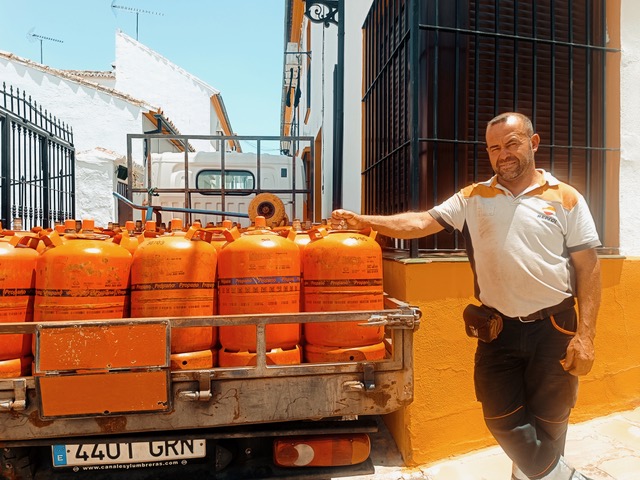
Rafa on an ordinary day. Photo © Karethe Linaae
Then, there are the large industrial gas containers.
-The big tanks which weigh 62 kilos, are sold to restaurants and hotels where there is a need for stronger pressure to push the gas up several stories. I also put those on my shoulder, but my colleagues carry them together.
The job consists of fetching the gas cylinders at the local depot and delivering them to customers, whether they are businesses or private clients. Rafa almost always works alone. Together with two other bomboneros, the three of them deliver all the Repsol gas bottles in town in addition to supplying a handful of smaller villages in the vicinity. When they deliver to apartment buildings, they still must deliver straight to the client’s door. This means using the elevator when available. If there is none, or it is out of order, they must use the stairs. Rafa will usually take one tank on his shoulder and another one in his spare hand, and if he has more deliveries in one place, he uses a handcart.
-Our obligation is to deliver the gas tanks to the customer's door and not any further. But I always help the elderly customers and bring the bottles to where they store them. I even connect the bottles if they need me to. But not all bomboneros do that.
Rafa admits that it is impossible that the job does not affect one's back after so many years. When it comes to safety, the canisters lacked a safety valve in the past, so they exploded on occasion. But that doesn’t happen anymore, he assures me. Gas bottles in homes are much less common now than in the past, and every year there are more alternative energy sources. I ask Rafa if he believes his occupation will exist in 10 years' time.
- Yes, I believe so. There is gradually less work for us, but in the villages where it is more costly and difficult to lay gas pipes, I believe they still will need bottle deliveries.
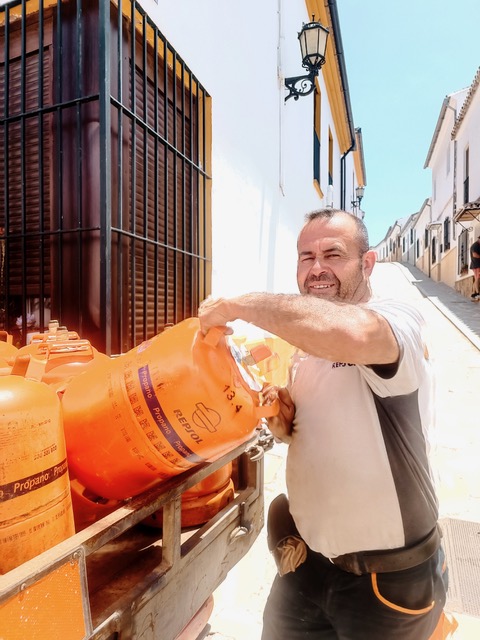
Heavy lifting. Photo © Karethe Linaae
According to our almost tireless gas man, the toughest part of the job is when he arrives at an apartment building without an elevator or when it is impossible to find parking in the town centre and he must walk for blocks to deliver the bottles. And the best thing about his occupation is the contact with the customers.
- After all these years I practically know everyone in town, and people almost always take time for a chat. Most people are nice, but of course, there are all kinds...
Just as quickly as it started, our conversation is over. Rafa pops a gas bottle up the street and returns with an empty one. Then he hurries on to some 99 other deliveries before his workday is over.
Gas deliveries are one of those everyday occurrences that one sees here in Spain, but perhaps not often think about. It might be a dying trade as our society moves steadfastly towards full automation and complete digitalization. But in the meantime, we can still enjoy hearing the jolly honking announcing that the gas man is here!
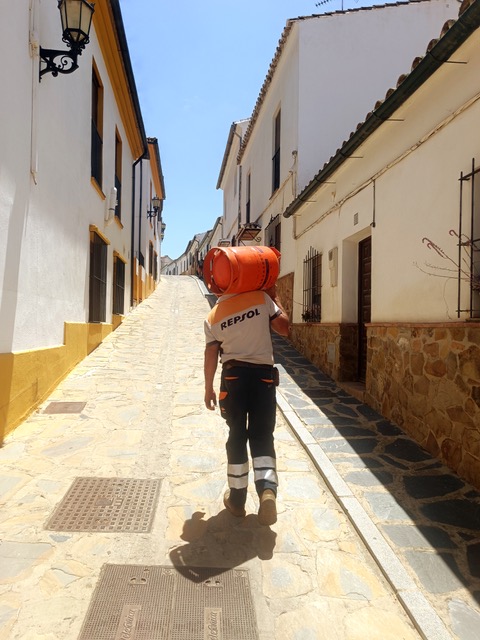
99 deliveries left to go. Photo © Karethe Linaae